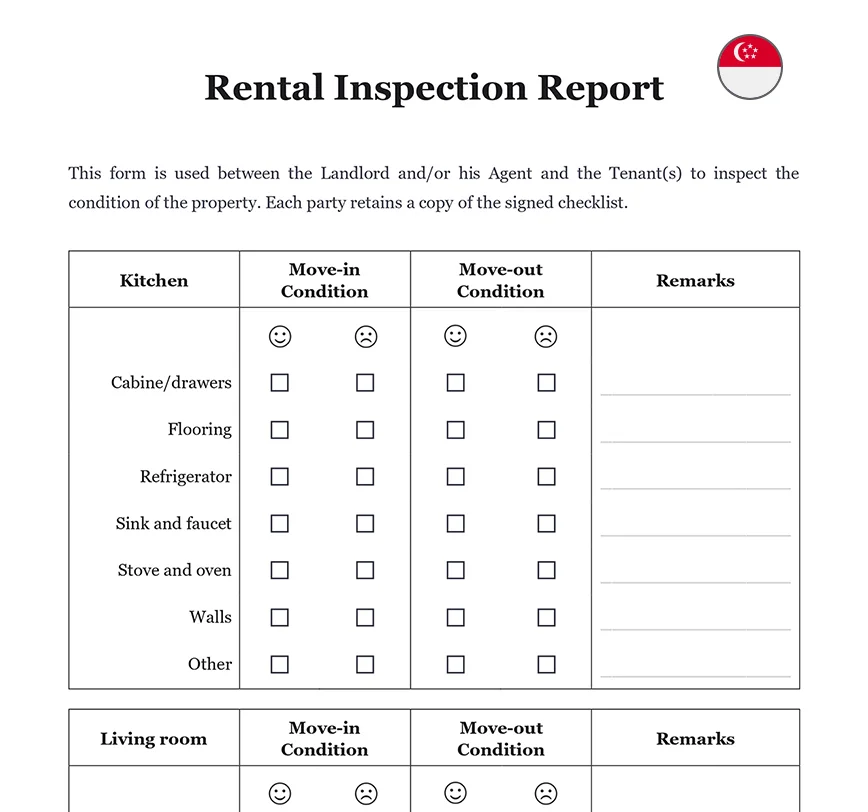Ready to use legal template
Work on without any hassle
Compliant with Singapore law
Ready to use legal template
Work on without any hassle
Compliant with Singapore law
Home › Rent your property › Rental inspection report
Learn more about Rental Inspection Report in Singapore
To secure your property, conduct a rental inspection checklist when tenants move in and out. The owner or property manager uses a rental inspection report or checklist to document the condition of a unit before and after the tenant moves in. This Rental Inspection Report helps you to secure your Singapore villa, home, condominium, or apartment. The goal is to document any damage to the property both before and after the rental. This document also informs the owner or property management about the repairs that the previous renter was accountable for. Finally, a rental inspection report will enable you to see the status of your rental property and organize the condition of each room prior to and after the rental. A copy of the signed checklist is kept by each party.
Table of contents
What is a Rental Inspection Report?
A landlord or property manager will utilize a rental inspection report to document the state of a rental property before and after a tenant moves in and out. The goal is to detail any property damage before and after the tenancy so that the landlord or property management understands what repairs the most recent renter is accountable for.
What are the different kinds of Rental Inspection Reports?
If property owners wish to Rent a property to tenants, they need be conversant with each sort of property inspection. These checks can protect landlords in the case of an accident on the property. Always include written evidence (preferably, signed by both sides) and time-stamped images when conducting official landlord inspections.
Property inspection before moving in
Before the tenant moves into the rental property, a move-in inspection should be performed. This allows both parties to assess and confirm the condition of the property’s features such as flooring, appliances, plumbing, and so on. Take pictures of any problems that are discovered, such as a carpet stain. New renters should not be held liable for any problems discovered during the move-in inspection. Landlords might make plans to address any issues before or shortly after the renters move in.
Inspections every three months
Although not all property managers conduct quarterly inspections, landlords can arrange for them to check that the tenant is following the terms of the Lease Agreement and that the property is being cared for as agreed. It’s ideal to notify renters as soon as they decide to rent so that you can schedule quarterly inspections.
Inspections of moving out
It’s critical to do a comprehensive examination when your renter vacates the rental property. This permits the property owner to record any damages to the property. Landlords should compare their lists during their move-in inspection.
In other circumstances, property damage may have already existed when the renters moved in. The move-out inspection serves as the foundation for any charges that the landlord wishes to levy on leaving tenants.
These costs are normally taken from the security deposit. They can then refund the remainder of the deposit to the tenants.
Landlords can submit an Invoice to leaving renters if the damages exceed the security deposit. If renters refuse to pay, landlords have the option of taking them to court. These aren’t pleasant circumstances, but they are sometimes an unavoidable aspect of renting. These are also the reasons why appropriate inspections and paperwork are essential in-home rentals.
Before we begin, it’s important to note that signing a lease agreement without understanding the clauses in one can put you in an unfavourable position. When in doubt on any terms in the agreement, you should clarify them with your property agent or landlord.
If you’re told to ignore anything, don’t–it could put you in a worse situation later. For example, you might find yourself in a dispute with your landlord due to misunderstandings on the rental conditions.
Who can benefit from a Rental Inspection Report?
Property owners and managers should employ a home inspection checklist at the start and conclusion of each new tenancy. If one is not given, tenants may request one from their landlord.
A rental inspection checklist should be used for any sort of rental property, including a(n):
1. A single-family attached or detached home;
2. An apartment, condo, duplex, or townhouse;
3. A basement suite or room; or any other sort of residential rental property.
Informations to provide for a Rental Inspection Report?
You will need the following items to complete your rental inspection report:
| ➤ Landlord information, such as contact information |
| ➤ A date for moving in or leaving |
| ➤ Tenant information |




